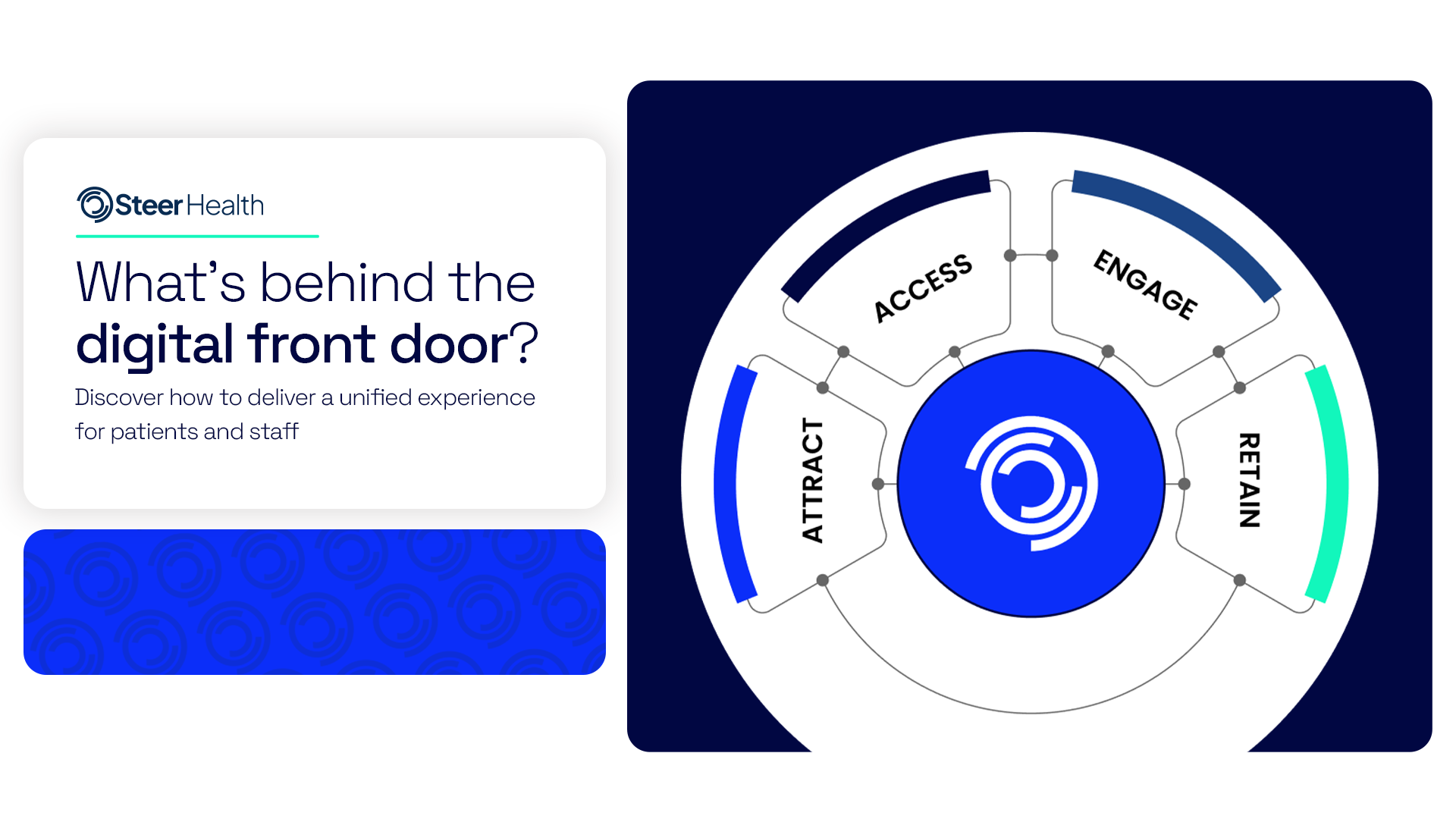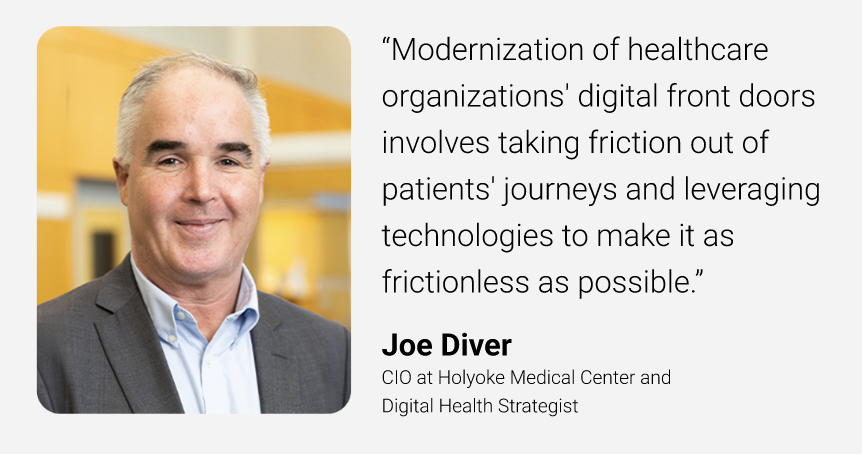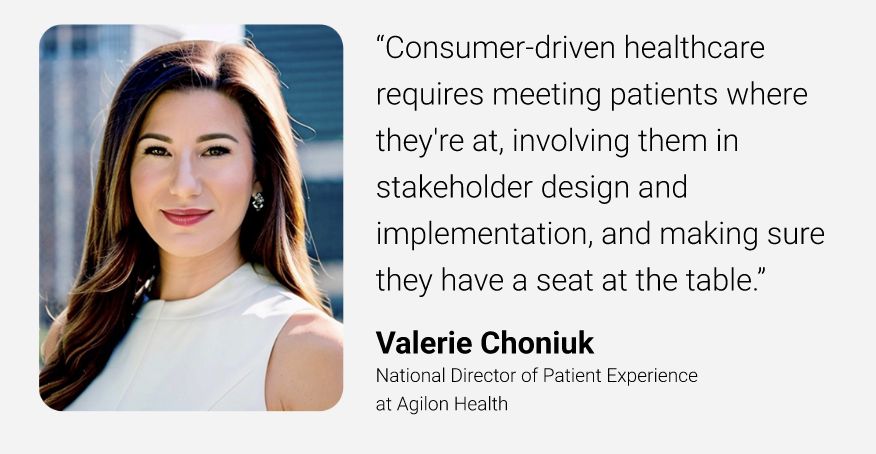Did you happen to miss our fascinating webinar on optimizing patient and staff experiences? Fear not! We’ve got you covered with the executive summary and the recording of the webinar!
Our esteemed speakers included Valerie Choniuk, the National Director of Patient Experience at Agilon Health, and Joe Diver, the CIO of Holyoke Medical Centre and a renowned digital health strategist. Both shared their valuable insights and expertise in healthcare and digital innovation during this exciting meeting.
Now let’s dive into the key takeaways from this insightful webinar!
What’s a digital front door in healthcare?
A digital front door serves as the gateway to personalized healthcare experiences by utilizing accessible data and technology to understand the unique needs of patients.
It facilitates seamless interactions between patients and providers, starting from attracting new patients and raising awareness about healthcare services, to improving accessibility through tools like telemedicine and online scheduling. This interface also ensures ongoing engagement throughout the patient journey, enabling end-to-end messaging and care communication. Furthermore, it plays a vital role in retaining patients by anticipating their future care needs and maintaining their engagement even after their care cycles have completed.
Joe Diver sheds light on the obstacles encountered by healthcare staff when it comes to managing appointment scheduling and dealing with staffing shortages. He emphasizes the importance of integrating technology to elevate service levels and enhance data analytics within healthcare organizations to operate more smoothly.
Valerie highlights the importance of an omni-channel approach for interaction and making it easier for patients, family, and caregivers to access information and services. She argues that a digital front door should enable the human experience, not replace it, by providing a unifying experience that is fluid and compassionate, and that reduces friction and stress for both patients and healthcare providers.
What’s the benefit of Digital Front Doors for healthcare organizations?
By establishing a strong digital front door, healthcare organizations cannot only reduce wait times but also create a more desirable experience for patients. This ultimately leads to higher levels of patient satisfaction and loyalty.
Furthermore, by utilizing AI to handle repetitive tasks, healthcare providers can dedicate their time and expertise to delivering value-based care and nurturing meaningful relationships with their patients. This becomes even more crucial during significant occasions and events where human skills and compassion play a pivotal role in patient experiences.
Opportunities for improving patient experiences via DFDs
In the realm of digital healthcare, an opportunity arises when there is alignment between value-based care and fee-for-service models. This can be done by utilizing technology to guide patients to the appropriate level of care at the right time, thereby reducing any obstacles they may face and increasing the number of appointments.
It is also crucial to create a positive initial impression even before patients actively seek care, as people are willing to go to great lengths to find specialists who can provide them with exceptional experiences.
Opportunities for revenue growth.
Diminished revenue growth can often be attributed to a lack of investment in technology and a failure to prioritize the patient experience. Instead of solely focusing on investments in electronic medical records (EMR), healthcare organizations should allocate budgets across multiple service lines to drive return on investment (ROI) and enhance patient engagement. By adopting this approach, organizations can foster growth and improve the overall healthcare experience for patients.
Improving DFD experiences in healthcare.
Data standardization presents a significant hurdle for organizations striving to enhance their Digital Front Door (DFD) experiences. It underscores the importance of a gradual learning approach, starting with crawling, then walking, and ultimately running, to leverage the power of data effectively. An intriguing study highlighted by Joe Diver revealed that an AI model exhibited 45% more compassion than physicians, illustrating the immense potential for data to revolutionize patient care and elevate the overall healthcare experience.
Where can you start improving your organization’s DFD?
Joe recommends starting by mapping out the patient’s journey, placing their needs at the center to identify any areas of friction and create a roadmap for improvement.
Valerie suggests focusing on simplicity and ease, involving frontline staff in the process. She emphasizes the importance of creating a unified perception strategy that bridges the gap between patient expectations and healthcare operations. Additionally, she highlights the significance of user-centric design and testing to ensure an optimal experience for all users.
Stakeholders involved in improving the DFD
So, how do you go about implementing a successful digital front door? Well, it all starts with establishing a solid cultural foundation that supports your digital front door strategy. Getting buy-in from leadership is absolutely crucial for the successful implementation of a digital front door.
Vendor selection and ROI expectations for digital tools
When selecting a partner to enhance patient experience and communication, it is essential to prioritize vendor customer service and flexibility. It is crucial to find vendors who excel in customer service and are adaptable in addressing challenges and obstacles.
Furthermore, measuring the success of digital front door tools is of utmost importance. Joe recommends tracking key metrics and establishing baseline measurements to drive improvements. Tangible outcomes and return on investment (ROI) are necessary to propel projects forward and demonstrate the impact of these tools.
Actionable takeaways from Steer’s webinar:
- It is crucial to prioritize a patient-centric approach to the digital front door (DFD), as well as a staff-centric approach, with a synchronized strategy that involves all stakeholders. Staff members play a critical role in educating patients and identifying areas of improvement to address in a timely manner, as they are also patients themselves.
- Simplify the measurement of consumer experience to avoid unnecessary complexity.
- Utilize digital technologies to enhance healthcare experiences for patients and their families.
- Establish a group of patients to gather valuable feedback on ways to improve the DFD experience.
- Seek strategic guidance on how to assess and enhance the digital front door of healthcare organizations.
Are you looking for strategic advice on enhancing your Digital Front Door? Get a free assessment of your digital capabilities to start your optimization journey! Click here for requesting a Free Assessment of your Digital Front Door!











